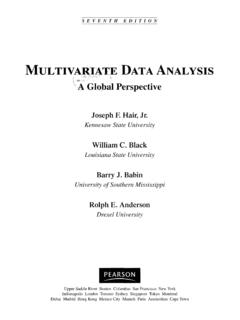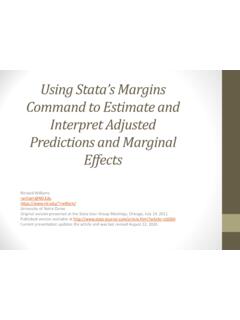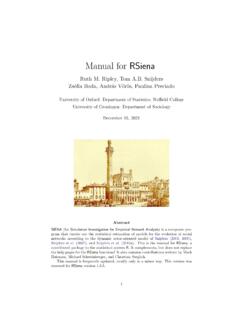Transcription of Reevaluating the Deterrent Effect of Capital Punishment ...
1 The author(s) shown below used Federal funds provided by the Department of Justice and prepared the following final report: Document Title: Reevaluating the Deterrent Effect of Capital Punishment : Model and Data Uncertainty Author(s): Ethan Cohen-Cole ; Steven Durlauf ; Jeffrey Fagan ; Daniel Nagin Document No.: 216548. Date Received: December 2006. Award Number: 2005-IJ-CX-0020. This report has not been published by the Department of Justice. To provide better customer service, NCJRS has made this Federally- funded grant final report available electronically in addition to traditional paper copies. Opinions or points of view expressed are those of the author(s) and do not necessarily reflect the official position or policies of the Department of Justice. This document is a research report submitted to the Department of Justice.
2 This report has not been published by the Department. Opinions or points of view expressed are those of the author(s). and do not necessarily reflect the official position or policies of the Department of Justice. Reevaluating the Deterrent Effect of Capital Punishment : Model and Data Uncertainty Ethan Cohen-Cole1. Steven Durlauf Jeffrey Fagan Daniel Nagin Abstract While issues of deterrence lie at the heart of criminal justice policy, there are important contexts where the studies of deterrence effects have failed to provide anything close to a scholarly consensus. A principle example of this are laws on Capital Punishment . Proponents argue that such laws prevent murders because potential criminals fear such strong Punishment . Opponents argue that deterrence arguments do not apply in these circumstances and/or that the statistical analyses suffer from grave flaws.
3 Each side can cite many statistical studies in support of its claims. This paper presents a methodology by which one can integrate the various studies into a single coherent analysis. We use a methodology generally called model averaging by which one takes weighted averages of a wide set of possible models of deterrence. Our conclusion is that there is little empirical evidence in favor of the deterrence hypothesis. 1. Cohen-Cole: Federal Reserve Bank of Boston, 600 Atlantic Avenue, Boston, MA 02210. (617) Durlauf: Department of Economics, University of Wisconsin. 1180. Observatory Drive, Madison WI, 53706-1393; Fagan: Columbia University School of Law; 435 West 116th Street Room 634, Box D-18 New York NY 10027; Nagin: H. John Heinz III School of Public Policy & Management; Carnegie Mellon University 5000 Forbes Avenue.
4 Pittsburgh, PA 15213-3890. The Department of Justice's National Institute of Justice has provided financial assistance. We are grateful for research assistance provided by Jon Larson. The views expressed in this paper are solely those of the authors and do not reflect official positions of the Federal Reserve Bank of Boston or the Federal Reserve System. This document is a research report submitted to the Department of Justice. This report has not been published by the Department. Opinions or points of view expressed are those of the author(s). and do not necessarily reflect the official position or policies of the Department of Justice. Reevaluating the Deterrent Effect of Capital Punishment : Model and Data Uncertainty Ethan Cohen-Cole1. Steven Durlauf Jeffrey Fagan Daniel Nagin Executive Summary While issues of deterrence lie at the heart of criminal justice policy, there are important contexts where the studies of deterrence effects have failed to provide anything close to a scholarly consensus.
5 A principle example of this are laws on Capital Punishment . Proponents argue that such laws prevent murders because potential criminals fear such strong Punishment . Opponents argue that deterrence arguments do not apply in these circumstances and/or that the statistical analyses suffer from grave flaws. Each side can cite many statistical studies in support of its claims. Efforts to change the policy landscape are ongoing and policymakers continue to struggle with the interpreting the results of conflicting studies. Thirty-eight states currently have a death-penalty law. The Capital Punishment literature has been marked by strongly opposing views. Since Issac Ehrlich's original contributions in (1975) and (1977), the field has produced a range of papers supporting and opposing Capital Punishment .
6 The fundamental problem that underlies the disparate findings on deterrence effects of death sentencing is that individual studies reflect specific assumptions about the appropriate data, control 1. Cohen-Cole: Federal Reserve Bank of Boston, 600 Atlantic Avenue, Boston, MA 02210. (617) Durlauf: Department of Economics, University of Wisconsin. 1180. Observatory Drive, Madison WI, 53706-1393; Fagan: Columbia University School of Law; 435 West 116th Street Room 634, Box D-18 New York NY 10027; Nagin: H. John Heinz III School of Public Policy & Management; Carnegie Mellon University 5000 Forbes Avenue. Pittsburgh, PA 15213-3890. The Department of Justice's National Institute of Justice has provided financial assistance. We are grateful for research assistance provided by Jon Larson. The views expressed in this paper are solely those of the authors and do not reflect official positions of the Federal Reserve Bank of Boston or the Federal Reserve System.
7 This document is a research report submitted to the Department of Justice. This report has not been published by the Department. Opinions or points of view expressed are those of the author(s). and do not necessarily reflect the official position or policies of the Department of Justice. variables, model specification, etc. on the part of the researcher, and can have major effects on the conclusions of a particular data analysis. The existing research on this topic comes to sufficiently differing conclusions predicated upon one or more underlying assumptions to call into question the ability of any single model to explain the impact of execution laws. Such dependence on the specifics of research design, from data cleaning to aggregation to model choice, forms the basis for the use of averaging techniques.
8 That is, since relatively minor variations in model or variable choice can lead to dramatic changes in conclusions, one suspects that inclusion of the information content of all of these models would lend itself to conclusions upon which policymakers could be more confident. This paper will describe a method which accounts for model uncertainty and places into a form that is easily interpretable to policymakers. More generally, the structure of model averaging may be understood as follows. Suppose one wishes to produce an estimate of some object of interest which measure the effects of a policy. In the context of the Capital Punishment literature, tends to be the coefficient on the execution variable in some deterrence regression. Conventional statistical methods may be thought of as calculating an estimate that is model specific, m.
9 In the model averaging approach, one attempts to eliminate conditioning on a specific model. To do this, one specifies a space of possible models M. The true model is unknown, so from the perspective of the researcher, each model will have some probability of being true. These model probabilities will depend both on the prior beliefs of the researcher as well as on the relative goodness of fits of the different models given available data D; hence each model will have a posterior probability: ( m D ) . These posterior probabilities allow us to average the model-specific estimates: = m ( m D ) . m Using this methodology, we estimate the Deterrent Effect of Capital Punishment . Our finding is that there is little evidence of a Deterrent Effect . This document is a research report submitted to the Department of Justice.
10 This report has not been published by the Department. Opinions or points of view expressed are those of the author(s). and do not necessarily reflect the official position or policies of the Department of Justice. Reevaluating the Deterrent Effect of Capital Punishment : Model and Data Uncertainty Ethan Cohen-Cole1. Steven Durlauf Jeffrey Fagan Daniel Nagin Section 1 Introduction While issues of deterrence lie at the heart of criminal justice policy, there are important contexts where the studies of deterrence effects have failed to provide anything close to a scholarly consensus. A principle example of this are laws on Capital Punishment . Proponents argue that such laws prevent murders because potential criminals fear such strong Punishment . Opponents argue that deterrence arguments do not apply in these circumstances and/or that the statistical analyses suffer from grave flaws.














